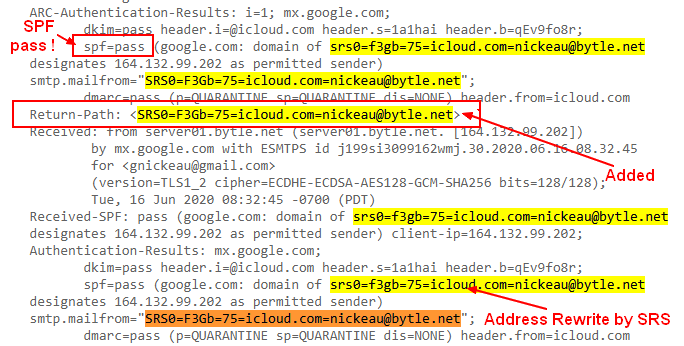About
This page is about the installation of postsrsd which implements Sender Rewriting Scheme (SRS) for Postfix. It's mandatory if you forward emails via the alias functionality.
Steps
Installation
- Package
yum install -y cmake unzip curl
- Temporary installation directory
mkdir -p /tmp/srs
cd /tmp/srs
- Download
curl -L -o master.zip https://github.com/roehling/postsrsd/archive/master.zip
# or
#wget https://github.com/roehling/postsrsd/archive/master.zip
- Unzip
unzip master.zip
- Install
cd postsrsd-master
# Optionally cmake you config (by default installed into /usr/lib)
make
make install
Configuration
SRS
Optional
cat /etc/default/postsrsd
# Default settings for postsrsd
# Local domain name.
# Addresses are rewritten to originate from this domain. The default value
# is taken from `postconf -h mydomain` and probably okay.
#
#SRS_DOMAIN=example.com
# Exclude additional domains.
# You may list domains which shall not be subjected to address rewriting.
# If a domain name starts with a dot, it matches all subdomains, but not
# the domain itself. Separate multiple domains by space or comma.
#
#SRS_EXCLUDE_DOMAINS=.example.com,example.org
# First separator character after SRS0 or SRS1.
# Can be one of: -+=
SRS_SEPARATOR==
# Secret key to sign rewritten addresses.
# When postsrsd is installed for the first time, a random secret is generated
# and stored in /etc/postsrsd.secret. For most installations, that's just fine.
#
SRS_SECRET=/etc/postsrsd.secret
# Length of hash to be used in rewritten addresses
SRS_HASHLENGTH=4
# Minimum length of hash to accept when validating return addresses.
# When increasing SRS_HASHLENGTH, set this to its previous value and
# wait for the duration of SRS return address validity (21 days) before
# increading this value as well.
SRS_HASHMIN=4
# Local ports for TCP list.
# These ports are used to bind the TCP list for postfix. If you change
# these, you have to modify the postfix settings accordingly. The ports
# are bound to the loopback interface, and should never be exposed on
# the internet.
#
SRS_FORWARD_PORT=10001
SRS_REVERSE_PORT=10002
# Drop root privileges and run as another user after initialization.
# This is highly recommended as postsrsd handles untrusted input.
#
RUN_AS=nobody
# Bind to this address
#
SRS_LISTEN_ADDR=127.0.0.1
# Jail daemon in chroot environment
CHROOT=/usr/local/lib/postsrsd
Postfix
In the main.cf conf file
sender_canonical_maps = tcp:localhost:10001
sender_canonical_classes = envelope_sender
recipient_canonical_maps = tcp:localhost:10002
recipient_canonical_classes= envelope_recipient,header_recipient
where the below parameters are for adress rewrite:
- rewrite of the sender
- postconf.5.html = tcp:localhost:10001 - corresponds to the SRS_FORWARD_PORT
- postconf.5.html = envelope_sender
- rewrite of the recipient
- postconf.5.html = tcp:localhost:10002 - corresponds to the SRS_REVERSE_PORT
- postconf.5.html = envelope_recipient,header_recipient
Services
systemctl enable postsrsd # to start it at boot
systemctl start postsrsd
systemctl restart postfix
Test
Send an email to your provider and check the received message. For instance, for gmail
You should see:
- the email rewrite
- and the added Return Path
- and a successful SPF test
Log
In the output of postsrsd, you should see the rewrite.
sudo systemctl status postsrsd
Jun 16 17:31:34 server01.bytle.net postsrsd[30592]: srs_forward: <[email protected]> rewritten as <[email protected]>
